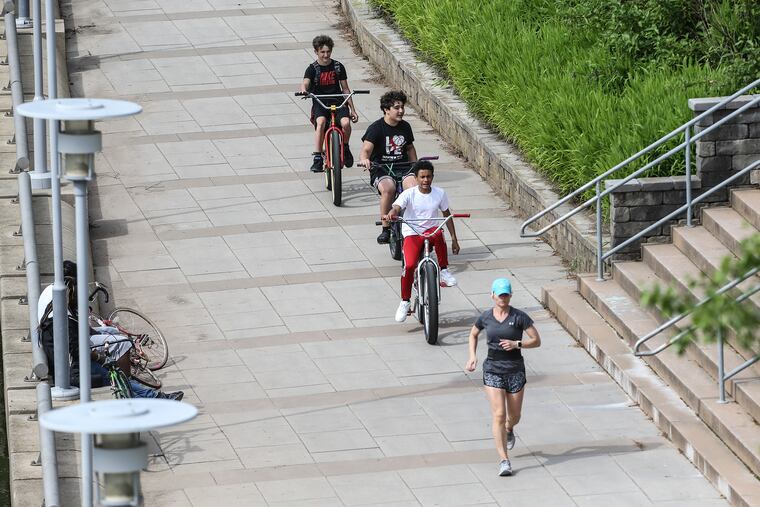Spring Garden’s makeover project has raised enough money to begin a trail-to-trail redesign
The project will link communities and two important recreational trails while making Spring Garden Street safer.

A group of people who have advocated for more than a decade to turn Philadelphia’s Spring Garden Street into a 2.1-mile “green boulevard” gathered Thursday to celebrate having pieced together $31 million to begin the environmental and traffic safety project.
When it’s finished, they say, the “Spring Garden Street Connector” will link popular trails on the Schuylkill and Delaware River and feature parking-protected bicycle lanes, trees, easier access to SEPTA rail stations and bus stops, a new stormwater management system, and safety improvements at 22 intersections to make the corridor more walkable.
“There are six neighborhoods along this corridor, and Spring Garden Street has been a chasm between them — now it will be a connector,” said Patrick Starr, executive vice chair of the Pennsylvania Environmental Council and a board member of the Circuit Trails. He’s acknowledged as a central player in assembling the coalition that has brought the project to this point.
» READ MORE: Philadelphians want protected bike lanes and pedestrian safety on Spring Garden Street
Last month, the William Penn Foundation approved a $2.1 million grant to support the connector, the final piece of the $5 million needed to proceed with the final design of the project, joining the state Department of Conservation and Natural Resources, the city’s Streets and Water Departments, and PennDot.
Philadelphia officials have allocated $26 million of the city’s federal transportation money to begin construction of the first stage of the project. It will cost more, but the exact amount — and the construction timeline — haven’t been determined, city transportation officials said.
“It’s a bit of a down payment, a commitment to the future,” said Sarah Clark Stuart, executive director of the Bicycle Coalition of Greater Philadelphia, one of the groups that has campaigned for the project.
Though busy, Spring Garden Street is not ranked among the most dangerous of the city’s 2,575 miles of roadways. Backers say the project has broad support because it can help meet safety, health, and environmental goals.
“In terms of the changing climate, transportation will be really enhanced by people getting out of their cars and on bikes, or going by foot” or transit, said Cindy Adams Dunn, secretary of the Pennsylvania Department of Conservation and Natural Resources.
In addition, she said, “if you’re in a hot rowhouse right around here, you need access to your river, the one that you own, to get there and cool off.”
DCNR has identified the gap between the Schuylkill River Trail and the Delaware River Trail as one of the most significant in the state’s network.
Spring Garden would become part of the regional Circuit Trails network in suburban Southeast Pennsylvania and South Jersey, and link Philadelphia to the East Coast Greenway, a 3,000-mile pedestrian and bicycle trail in development from Maine to Florida.
Design of the project could take up to two years, said Mike Carroll, the city’s deputy managing director in charge of the Office of Transportation, Infrastructure and Sustainability. In addition to protected bike lanes, Spring Garden Street will get updated traffic signals and pedestrian bump-outs at intersections, an example of a complete street, safe for drivers and all other users.
“It will transform what is a very harsh landscape. It’s very unfriendly. And it’s quite a dangerous street to navigate,” said John Chin, executive director of the Philadelphia Chinatown Development Corp. He praised the city Streets Department and OTIS for extensive community outreach.
Unlike the contentious Washington Avenue repaving and safety project, the Spring Garden project does not include a so-called road diet, or reduction in the number of lanes, Carroll said.
“There’s a lot of consensus around this,” he said.